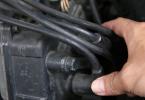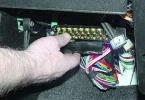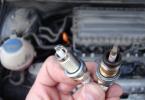A large number of car enthusiasts during the operation of the vehicle periodically face difficulties of launching the power unit. At the same time, quite often explicit prerequisites in the form of distinct faults are absent. An unexpected motor refusal to start can occur both during a cold start, and when trying to start a previously heated. In such cases, one of the most frequent reasons why the engine of the car does not start, is that the motor fills with candles with gasoline or oil.
In the event that the candles flooded on or, the starting of the motor will be very difficult or completely impossible. This indicates certain problems with both the engine itself and individual elements and systems. In this article we will talk about why fills, how to understand what candles flooded, and what to do to the driver, if the machine does not start, pours candles with gasoline or motor oil, etc.
Why pours candles when starting the engine to cold
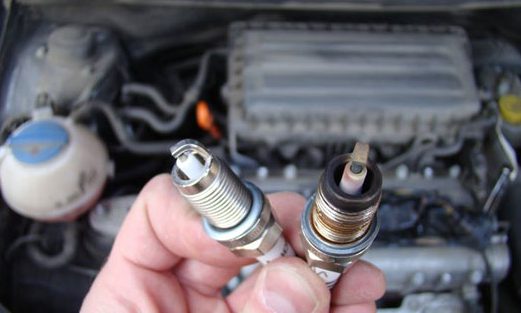
Let's start with the fact that in the warm season the problem of flooding candles is not as relevant compared to the cold. As a result, more frequent phenomenon becomes the fact that the candles flooded in the frost. The main signs of filled candles:
- the problem is manifested in such a way that it is scrolled by the starter, but the engine does not "grab";
- from the exhaust pipe smells gasoline, the smell is distinct at the moment;
- after unscrewing the candles, the carving and electrodes in gasoline, in the lower part of the spark plug, there is also a dark nagar;
We add that the fuel pouring occurs regardless of which power system is installed on a specific TC (engine with an injection injection or carburetor option). The only thing to compare the injector and the carburetor is poured candles on the injector in the frost somewhat less often. Also, some fuel features can be somewhat different taking into account the individual characteristics of a power system.
So, fills the spark plugs (especially at negative temperatures) as a result of the fact that the fuel enters the combustion chamber from the power system, but the fuel ignition does not occur. Candles become wet, after which the further normal process of sparking is obtained impossible, that is, the motor will not be displayed.
As practice shows, a list of reasons why composes candles to a cold injector or when a similar problem occurs on a carburetor car, includes several main points:
- Low charge. In this case, the battery is discharged by more than 40-60%. In conditions of reduction of outdoor temperature, the battery may not produce the desired power sufficient for the normal operation of the starter and the functioning of the ignition system. As a result, the fuel is supplied to the power system to the cylinders, but the ignition does not occur and fuel fills the candles.
- Fault. Problems may occur both with ignition candles themselves and with. If the candles are old, then they may have irregular gaps, various defects of the housing and electrodes. Spark on such candles may be weak or absent. As for high-voltage wires, they may be damaged, contrary to the contacts, etc. Parallel should be checked and other structural elements of the ignition system that can cause a spark on the candle.
- Low quality fuel. In winter, the ease of its ignition depends on the purity and total amount of impurities in the fuel during the cold start. It should also be borne in mind that in the winter in the fuel tank, condensate can be harvested, which also enters gasoline. A combination of such factors leads to the fact that there is a spark on the candlelight, but the fuel cannot ignite in a timely manner. The result becomes a non-working engine and wet candles.
In practice, it looks like this. For example, in injection engines takes into account the outer temperature and the temperature of the engine, the amount of oxygen in the air entering the engine, etc. The control unit submits the corresponding command to the nozzles to increase the amount of fuel at such a need, that is, enriches the fuel and air mixture for a confident cold start and further stable operation of the power unit (the so-called warm-up turnover of XX). In accordance with the resulting signal from the ECU, the injector nozzles are injected by a larger amount of fuel.
And now let's imagine that the engine is no longer new, that is, there is some wear. This means that compression in the cylinders is still within the limits of permissible indicators, but not ideal. You can also add a slightly hooked battery to this, thickened oil in the CARTER CARTER and flare on the ignition candlelight. It turns out the following:
- the nozzles are actively fed not the best in the quality of the fuel in the cylinders, which is also poorly evaporated under conditions of low temperature;
- the starter slowly twists the crankshaft in the thickened lubricant from the unsavded battery;
- in the cold engine, the parts are not expanded on heating, the gaps are increased, the compression is reduced;
- the ignition system generates a weak spark on contaminated candles, which is not enough to ignite the fuel and air charge;
Of course, in the example above, a whole set of possible problems is described. However, taking into account the above, it becomes clear that each "link", even taken separately, can already lead to difficulties during the start and certain failures. In other words, only problems with batteries or high-voltage wires can be quite enough, so that after one or two unsuccessful attempts to start the driver already poured candles in winter. It turns out, the minimum impulse to ignite fuel is simply not enough or the spark was not initially. Separately, add that if it fills a candle on the cylinder, while only one is distinguished, then it should not be excluded the likelihood of low compression or other problems only in this engine cylinder.
I am a spark, the starter turns normally, but the spark plugs fills
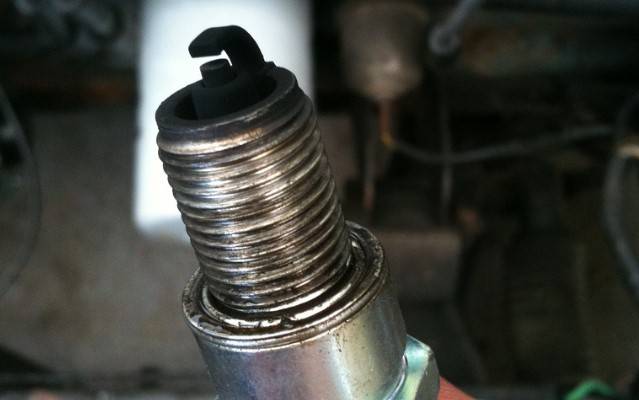
It is often possible to encounter such a situation where the spark is, the candles fills, while the starter turns the crankshaft well. In a similar case, the spark plugs may need a separate check, since the presence of sparks on them does not mean that the same spark will always be created under pressure. In other words, if there was a spark on the outflowed candle, then after installation on the motor, it may disappear. The reason is the increased pressure in the combustion chamber, which is created during the operation of the engine. To clarify, you need to diagnose on a special stand for checking the ignition candles, which simulates the operation of these elements, taking into account the high pressure (similar to the work of the candles in the combustion chamber).
Even the attention should be paid to the phases of the gas distribution, since their failure may cause inspired candles. Note that in motors with an injector are also possible problems with the bypass valve in the fuel rail. To exclude the probability of its troubleshooting, it will be necessary to measure the fuel pressure in the ramp. It is important to understand that the fuel must be supplied in cylinders under certain pressure. Deviations both in greater and in a smaller side can lead to pouring candles and the inability to start the engine.
In parallel, the injectors and sensors may need in diagnostics. For example, the coolant temperature sensor in the event of a malfunction can send incorrect data to the computer. In this case, the control unit enriches the mixture and nozzles overflow the fuel. In rare cases, the electronic engine control unit itself fails.
Pours sprinkle candles with engine oil
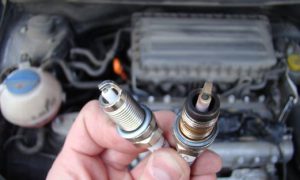
In addition, the candles can be flooded with gasoline, there are cases when the engine flooded with oil candles, poured with an oil with a candle in one cylinder, and the like. This malfunction occurs both in the injector and on motors with a carburetor.
If the candles fill with oil, then it should be more accurate to decide how the candles floods, on top or bottom, that is, what part of the candle is contaminated. The accumulation of lubricant from above (in the candlestones) indicates that, for example, problems arose with a valve cover laying or other seals. In this case, the ingress of oil leads to the fact that the spark begins to break through and the cylinder or several cylinders do not work as a result.
After unscrewing the candle on a carving, a clear black nagar can be viewed or missing, oil can also get from the well right on the thread during the tweezing of the candle, etc. In the event that oil floods the candles from below, that is, in the cylinder itself, then the compression in the engine should be measured. The likelihood is highly worn, and oil-chained rings clutched or lay. It is also possible to wear the walls of cylinders or, failure (valve oil seals), the appearance of cracks in, problems with valve guides and other malfunctions, which lead to the enhanced lubricant in the combustion chamber and grinding the spark plugs.
Candle flooded: what to do to the driver
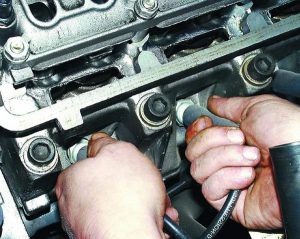
Suppose the engine does not start and you are sure that the reason is gasoline on the ignition candlelight. In such a situation it is useful to know what can be taken in the event that the candles flooded, how to start the car in such conditions, etc.
Let's start with the fact that there are several ways available how to dry off the candles. To begin with, in the manual for the operation of many cars, it is separately indicated that if the candles flooded with a gasoline on an injection motor, then they need to be turned out using a candle wrench and dry. Then the engine should be scrolled by a starter for about 10 seconds with removed candles. Further, the candles are screwed back, after which an attempt is attempted to start the FCs in normal mode.
Also, many drivers in case of infusion of candles start the engine with the purge of cylinders. In some cases, this method allows you to start a motor without cutting the candles. To purge cylinders on the injection engine, you need to squeeze the gas pedal until it stops before starting. Next, the starter scrolls the crankshaft for about 10 seconds, then the gas pedal can be released. Such actions help the power unit to start. The purge occurs due to the fact that with an open throttle in the cylinders, a large amount of air falls into the cylinders, the candles are dried.
If the engine with purge did not start, then the candles will have to be dried manually and. To do this, they need to unscrew, after which it is cleaned from Nagara. You can use a soft brush (a brush for cleaning the teeth) or a brush with a metal bristle is suitable. In the second case, care must be taken, clean it without effort. Candles are dried by a domestic or construction hairdryer, calcined on the gas burner, put in the oven. Next, you need to check the gap between the electrodes, after which you can screw the items back to the engine. As a result, the re-launch must pass without difficulty.
We add that many experts described above are recommended not to implement if it is possible to immediately acquire new spark plugs. Simple words, cleaning and calcining leads to the fact that the candle resource after such actions is noticeably reduced, the gaps are knocked, these elements are worse after cleaning. It turns out that it is more profitable to purchase relatively low-cost new candles than to clean, dry and then install the old ones. It also noted that simple spark plugs from the average price range are desirable to change every 15-25 thousand kilometers, regardless of their condition and appearance.
It should also be borne in mind that if new or brushed candles pours constantly, then the reason must be sought separately, and not just to solve the problem with cleaning or changing these items. In this case, the motor needs in-depth diagnostics, the ignition system, nozzles, ignition coil, temperature sensor, etc. are checked.
Let's summarize
Taking into account the above, it becomes clear that it is necessary to create certain conditions for normal starting and engine operation. It is also important to remember that the increased requirements are put forward in winter. In an effort to achieve a stable start, novice car enthusiasts often ask which candles does not flood. You can immediately answer that in the event of a failure, any candles will fill, even new ones. This happens independently of the brand, the states of the candles themselves, design features, brand, etc.
Note that gasoline does not block the spark plugs, it is necessary:
- monitor the charge of the battery, reflect the battery using the charger;
- the starter must be properly, it is not allowed to swallowing, slipping, etc.;
- an oil must be poured into the engine, which corresponds to current operating conditions (viscosity suitable for winter, as well as other parameters);
- the power system must be absolutely good, the injector nozzles must be cleaned timely. It is advisable to resort to more effective methods for cleaning the nozzles ultrasound or wash the injector on a special washing stand, and not limited to the prophylactic additives of various cleaners in the fuel tank;
- refueling fuel is desirable only on proven gas stations that have certificates confirming the quality of fuel;
- regularly check the state of spark plugs and high-voltage wires;
Finally, add that the cluster of nagar in the combustion chamber can also lead to a hoped cold start and pouring / grinding candles. First of all, the likelihood of the piston rings or reducing their mobility is high. As a result, the compression may decrease, engine oil is entering the cylinders, etc. For this reason, the lubricant must be changed strictly according to the regulations, in some cases an additional flushing of the lubricant system with the effect of the piston rings is used. Also on highly focused DVS, you can conduct a comprehensive procedure from the piston and walls of the combustion chamber.
In order to prevent the Nagar formation in a working motor, experts are recommended to periodically unwind the power unit to high revolutions (about 4500-5000 rpm), after which it is necessary to drive at least 30-50 km in this mode. This is especially shown to cars that are constantly exploited in urban conditions. Factors such as: Long work on XX, short trips on low transmissions, low speed and riding with low speed, underwear of a motor (the unit does not have time to fully enter the operating temperature) lead to enhanced carcass and engine coke. Increase the revolutions and loads above the average mark allows you to implement partial cleaning of carpentry and sediments in the combustion chamber of the DVS naturally.
